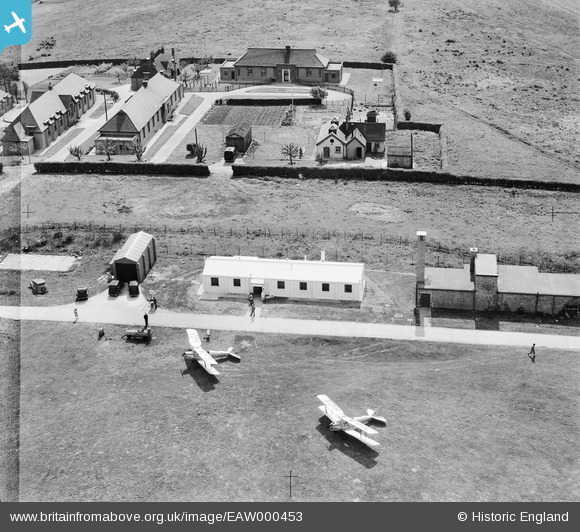© Hawlfraint cyfranwyr OpenStreetMap a thrwyddedwyd gan yr OpenStreetMap Foundation. 2025. Trwyddedir y gartograffeg fel CC BY-SA.
Manylion
| Pennawd |
[EAW000453] DH82A Tiger Moths G-AHDE and G-AHDF parked outside Luton Flying Club and Spittlesea Hospital, Luton, 1946 |
| Cyfeirnod |
EAW000453 |
| Dyddiad |
3-May-1946 |
| Dolen |
|
| Enw lle |
LUTON |
| Plwyf |
|
| Ardal |
|
| Gwlad |
ENGLAND |
| Dwyreiniad / Gogleddiad |
511364, 221195 |
| Hydred / Lledred |
-0.38201013419988, 51.877748008514 |
| Cyfeirnod Grid Cenedlaethol |
TL114212 |
Pinnau
 A pair of 1939 Ford Anglia E04A's.
The patriotically named first Ford Anglia, launched soon after Britain declared war on Germany in early September 1939,and given the internal Ford model code of E04A, was a facelifted version of the Ford 7Y, a simple vehicle aimed at the cheap end of the market, with few features. Most were painted Ford black. Styling was typically late-1930s, with an upright radiator, the external spare wheel on the rear identifies it from the later E494A. There were standard and deluxe models, the latter having better instrumentation and, on pre-war models, running boards. Both front and rear suspensions used transverse leaf springs, and the brakes were mechanical.
|

Billy Turner |
Wednesday 10th of February 2016 05:03:24 PM |
  2 Door Morris Eight series I
The car was powered by a Morris UB series 918 cc four-cylinder side-valve engine with three bearing crankshaft and single SU carburettor with maximum power of 23.5 bhp (17.5 kW). The gearbox was a three-speed unit with synchromesh on the top two speeds and Lockheed hydraulic brakes were fitted. Coil ignition was used in a Lucas electrical system powered by a 6 volt battery and third brush dynamo.
The body which was either a saloon or open tourer was mounted on a separate channel section chassis with a 7 feet 6 inches (2.29 m) wheelbase. The tourer could reach 58 mph (93 km/h) and return 45 miles per imperial gallon (6.3 L/100 km; 37 mpg-US); the saloons were a little slower. The chrome-plated radiator shell and honeycomb grille were dummies disguising the real one hidden behind. In September 1934 the bare chassis was offered for £95. For buyers of complete cars prices ranged from £118 for the basic two-seater to £142 for the four door saloon with "sunshine" roof and leather seats.[3] Bumpers and indicators were £2 10 shillings (£2.50) extra. |

Billy Turner |
Wednesday 10th of February 2016 04:11:51 PM |
  1935 Triumph Gloria 'Vitesse'.
Between 1934 and 1938 Triumph made a large and complex range of Gloria sporting saloons, coupés, tourers, 2-seater sports cars, drophead coupés and golfer’s coupés. All these Glorias, apart from the final two models (1.5-Litre Saloon and Fourteen (1767 cc) Six-Light Saloon of 1937-1938) were powered by 1087 or 1232 cc four-cylinder or 1467 or 1991 cc six-cylinder Coventry Climax overhead inlet and side exhaust valve designed engines (modified and built under licence by Triumph).
The chassis came in two lengths, with an extra 8 in (203 mm) ahead of the passenger compartment depending on whether the four- or six-cylinder engine was fitted, and had conventional non-independent suspension with semi elliptic leaf springs. The brakes were hydraulically operated using the Lockheed system with large 12 in (305 mm) drums. A four-speed transmission was fitted with an optional free wheel mechanism allowing "clutchless" gear changing. Synchromesh was fitted to the gearbox on the final Fourteen and 1.5-litre models.
From August 1934 to 1936 the Gloria range included ‘Vitesse’ models (not to be confused with later Vitesses) which were up-rated, with twin carburettor engine and equipment, versions of the equivalent Gloria and slightly different bodywork in the case of some saloons.
Gloria Southern Cross. |

Billy Turner |
Wednesday 10th of February 2016 02:02:22 PM |





![[EAW000453] DH82A Tiger Moths G-AHDE and G-AHDF parked outside Luton Flying Club and Spittlesea Hospital, Luton, 1946](http://britainfromabove.org.uk/sites/all/libraries/aerofilms-images/public/100x100/EAW/000/EAW000453.jpg)
![[EAW000451] DH82A Tiger Moths G-AHDE and G-AHDF parked outside Luton Flying Club at Luton Airport, Luton, 1946](http://britainfromabove.org.uk/sites/all/libraries/aerofilms-images/public/100x100/EAW/000/EAW000451.jpg)
![[EAW000452] DH82A Tiger Moths G-AHDE and G-AHDF parked outside Luton Flying Club at Luton Airport and environs, Luton, from the south-west, 1946](http://britainfromabove.org.uk/sites/all/libraries/aerofilms-images/public/100x100/EAW/000/EAW000452.jpg)


